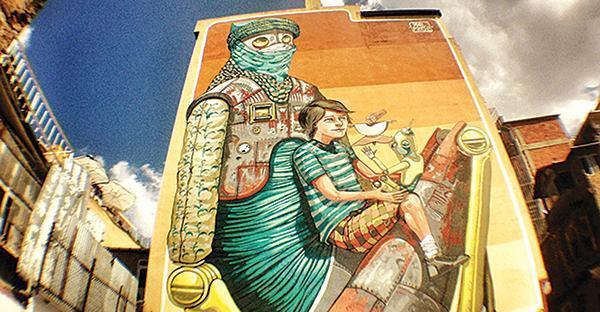Subverting Banksy in Istanbul
Emrah Güler - ANKARA

“When you go to an art gallery you are simply a tourist looking at the trophy cabinet of a few millionaires.” That’s how the most famous, ever-elusive British graffiti artist and political activist Banksy defined his views on and his relationship to the art scene (or more specifically, the hypocrisy of the art scene) in an interview in the early 2000s.
He wanted art, at least his own art, to be accessible and available. “You don’t have to go to college, drag ’round a portfolio, mail off transparencies to snooty galleries or sleep with someone powerful; all you need now is a few ideas and a broadband connection,” Banksy said. “This is the first time the essentially bourgeois world of art has belonged to the people. We need to make it count.”
He gained fame and notoriety across the world, transforming from an underground graffiti artist from Bristol (who honed his craft in stencil because he was not good with spray cans) into a global myth who made statements against social injustice, political corruption and corporate greed through claiming public locations with street art.
Banksy’s first London exhibition took place in an abandoned tunnel in 2001, with an impromptu and informal opening “which had cost almost nothing to set up.” As his work became more and more a delightful blend of street art and performance, Banksy targeted the art scene in a much bigger way. He managed to install an image of the Mona Lisa with a smiley-face plastered over, in the Louvre. He later stuck a photo of a woman with a gas mask over a wall in New York City’s Metropolitan Museum of Art.
‘Banksy is not represented by Steve Lazarides’
For those with any inkling of Banksy’s work, along with the political and social commentary he is now associated with through his work on the West Bank wall and many others, his recent exhibition in Istanbul, “The Art of Banksy,” came as a shock. As the website Artful Living’s Ahmet Ergenç pointed, “A Banksy caricature, a Banksy parody is presented, with all its seriousness, as a Banksy exhibition.”
The astronomical entrance fee, the live enactment of famous works such as “London Maid,” “Bomb Hugger” and “Flower Thrower,” the gift shop (not a send-up to Banksy’s 2010 Oscar-nominated film, “Exit Through the Gift Shop”), and celebrity guests hoping to be “seen” at a Banksy exhibition seem like a giant prank right out of the graffiti artist’s repertoire. That is, in an alternate universe.
Another irony is that Banksy is apparently unaware (though not at the moment, probably) of “The Art of Banksy” exhibition, and it is organized by one of the few people who knows Banksy, his work, and the bold statements he’s been making: Banksy’s former agent and publicist, Steve Lazarides. A quick look at Banksy’s website will make clear their current relationship: “Banksy is NOT on Facebook, Twitter or represented by Steve Lazarides or any other commercial gallery.”
The overwhelming interest in the exhibition, mostly without the acknowledgement of the irony, could be attributed to the lack of a tongue-in-cheek humor, ignorance, or a culture of street art epitomized by aphorisms spread across walls, not much different than eons occupying the Twitter-verse.
Blossoming street art in Turkey
At a first glance, street art in Turkey is mostly words (some clever, others not so much) that became all the more visible following the Gezi Park protests in the summer of 2013. One of the many reactions, many examples of civil disobedience was the burst of creativity following the unexpected police brutality across Turkey.
The graffiti was the most immediate and most widespread expression of rebellion. Tumblr and Facebook pages were devoted to graffiti, street art and posters, putting smiles across faces of those on their computers, surfing social media frantically.
A keen eye, however, will see that street art in Turkey, in fact, is quite sophisticated with the elaborate drawings, stencil work and spray can paintings spread over the walls of big cities, especially Istanbul. The works of local artists like Canavar, Mone and Turbo blend with those of foreign artists, like Pixel Pancho, Dome and Amose. Istanbul apparently is a favorite destination for graffiti artists.
Some even make money out of their work. Take Dunc “Turbo” Dindas, for instance. He works as a commercial graffiti artist, putting a supposedly subversive touch on corporate culture, working for such giants like Coca-Cola, Samsung and Adidas. On the other hand, Banksy offers high-resolution images of his work for free downloading, maintaining, “I give away thousands of paintings for free. I don’t think it’s possible to make art about world poverty and trouser all the cash.” Meanwhile, somebody seems to be “trousering” the cash in Istanbul.
 “When you go to an art gallery you are simply a tourist looking at the trophy cabinet of a few millionaires.” That’s how the most famous, ever-elusive British graffiti artist and political activist Banksy defined his views on and his relationship to the art scene (or more specifically, the hypocrisy of the art scene) in an interview in the early 2000s.
“When you go to an art gallery you are simply a tourist looking at the trophy cabinet of a few millionaires.” That’s how the most famous, ever-elusive British graffiti artist and political activist Banksy defined his views on and his relationship to the art scene (or more specifically, the hypocrisy of the art scene) in an interview in the early 2000s. 
